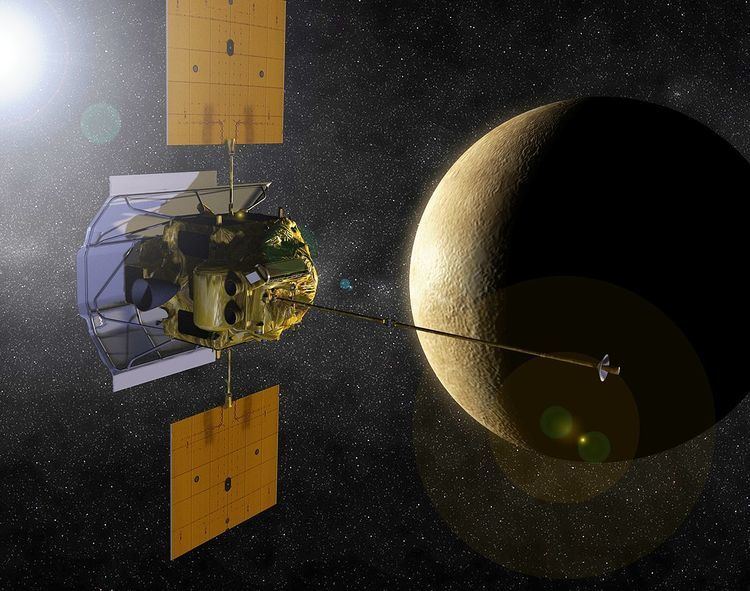 | ||
A robotic spacecraft is an uncrewed spacecraft, usually under telerobotic control. A robotic spacecraft designed to make scientific research measurements is often called a space probe. Many space missions are more suited to telerobotic rather than crewed operation, due to lower cost and lower risk factors. In addition, some planetary destinations such as Venus or the vicinity of Jupiter are too hostile for human survival, given current technology. Outer planets such as Saturn, Uranus, and Neptune are too distant to reach with current crewed spaceflight technology, so telerobotic probes are the only way to explore them.
Contents
- History
- Design
- Structure
- Data handling
- Attitude determination and control
- Telecommunications
- Electrical power
- Temperature control and protection from the environment
- Mechanical devices
- Control
- Space probes
- Robotic spacecraft service vehicles
- References
Many artificial satellites are robotic spacecraft, as are many landers and rovers.
History
The first robotic spacecraft was launched by the Soviet Union (USSR) on 22 July 1951, a suborbital flight carrying two dogs Dezik and Tsygan. Four other such flights were made through the fall of 1951.
The first artificial satellite, Sputnik 1, was put into a 215-by-939-kilometer (116 by 507 nmi) Earth orbit by the USSR) on 4 October 1957. On 3 November 1957, the USSR orbited Sputnik 2. Weighing 113 kilograms (249 lb), Sputnik 2 carried the first living animal into orbit, the dog Laika. Since the satellite was not designed to detach from its launch vehicle's upper stage, the total mass in orbit was 508.3 kilograms (1,121 lb).
In a close race with the Soviets, the United States launched its first artificial satellite, Explorer 1, into a 193-by-1,373-nautical-mile (357 by 2,543 km) orbit on 31 January 1958. Explorer I was a 80.75-inch (205.1 cm) long by 6.00-inch (15.2 cm) diameter cyllynder weighing 30.8 pounds (14.0 kg), compared to Sputnik 1, a 58-centimeter (23 in) sphere which weighed 83.6 kilograms (184 lb). Explorer 1 carried sensors which confirmed the existence of the Van Allen belts, a major scientific discovery at the time, while Sputnik 1 carried no scientific sensors. On 17 March 1958, the US orbited its second satellite, Vanguard 1, which was about the size of a grapefruit, and remains in a 360-by-2,080-nautical-mile (670 by 3,850 km) orbit as of 2016.
Nine other countries have successfully launched satellites using their own launch vehicles: France (1965), Australia (1967), Japan and China (1970), the United Kingdom (1971), India (1980), Israel (1988), Iran (2009), and North Korea (2012).
Design
In spacecraft design, the United States Air Force considers a vehicle to consist of the mission payload and the bus (or platform). The bus provides physical structure, thermal control, electrical power, attitude control and telemetry, tracking and commanding.
JPL divides the "flight system" of a spacecraft into subsystems. These include:
Structure
This is the physical backbone structure. It:
Data handling
This is sometimes referred to as the command and data subsystem. It is often responsible for:
Attitude determination and control
This system is mainly responsible for the correct spacecraft's orientation in space (attitude) despite external disturbance-gravity gradient effects, magnetic-field torques, solar radiation and aerodynamic drag; in addition it may be required to reposition movable parts, such as antennas and solar arrays.
Telecommunications
Components in the telecommunications subsystem include radio antennas, transmitters and receivers. These may be used to communicate with ground stations on Earth, or with other spacecraft.
Electrical power
The supply of electric power on spacecraft generally come from photovoltaic (solar) cells or from a radioisotope thermoelectric generator. Other components of the subsystem include batteries for storing power and distribution circuitry that connects components to the power sources.
Temperature control and protection from the environment
Spacecraft are often protected from temperature fluctuations with insulation. Some spacecraft use mirrors and sunshades for additional protection from solar heating. They also often need shielding from micrometeoroids and orbital debris.
Mechanical devices
Mechanical components often need to be moved for deployment after launch or prior to landing. In addition to the use of motors, many one-time movements are controlled by pyrotechnic devices.
Control
Robotic spacecraft use telemetry to radio back to Earth acquired data and vehicle status information. Although generally referred to as "remotely controlled" or "telerobotic", the earliest orbital spacecraft – such as Sputnik 1 and Explorer 1 – did not receive control signals from Earth. Soon after these first spacecraft, command systems were developed to allow remote control from the ground. Increased autonomy is important for distant probes where the light travel time prevents rapid decision and control from Earth. Newer probes such as Cassini–Huygens and the Mars Exploration Rovers are highly autonomous and use on-board computers to operate independently for extended periods of time.
Space probes
A space probe is a scientific space exploration mission in which a spacecraft leaves Earth and explores space. It may approach the Moon, enter interplanetary, flyby or orbit other bodies, or approach interstellar space.
